
Mahavira, also known as Vardhamana, was the 24th Tirthankara of Jainism. He was the spiritual successor of the 23rd Tirthankara Parshvanatha. Mahavira was born in the early 6th century BCE to a royal Jain family of ancient India. His mother's name was Trishala and his father's name was Siddhartha. They were lay devotees of Parshvanatha. Mahavira abandoned all worldly possessions at the age of about 30 and left home in pursuit of spiritual awakening, becoming an ascetic. Mahavira practiced intense meditation and severe austerities for twelve and a half years, after which he attained Kevala Jnana (omniscience). He preached for 30 years and attained moksha (liberation) in the 6th century BCE, although the year varies by sect.

In Jainism, a Tirthankara is a saviour and supreme spiritual teacher of the dharma. The word tirthankara signifies the founder of a tirtha, a fordable passage across saṃsāra, the sea of interminable birth and death. According to Jains, tirthankaras are the supreme preachers of dharma, who have conquered saṃsāra on their own and made a path for others to follow. After understanding the true nature of the self or soul, the Tīrthaṅkara attains kevala jnana (omniscience). A Tirthankara provides a bridge for others to follow them from saṃsāra to moksha (liberation).

Lake Manasarovar, also called Mapam Yumtso locally, is a high altitude freshwater lake fed by the Kailash Glaciers near Mount Kailash in Burang County, Ngari Prefecture, Tibet Autonomous Region, China. The Indus River is near the lake. The lake along with Mount Kailash to its north are sacred sites in four religions: Hinduism, Jainism, Buddhism and Bön.

Shikharji, also known as Sammed or Sammet Shikharji, is one of the Holiest pilgrimage sites for Jains, in Giridih district, Jharkhand. It is located on Parasnath hill, the highest mountain in the state of Jharkhand. It is the most important Jain Tirtha, for it is the place where twenty of the twenty-four Jain tirthankaras along with many other monks attained Moksha. It is one of the five principal pilgrimage destinations along with Girnar, Pawapuri, Champapuri, Dilwara, Palitana and Ashtapad Kailash.

Jainism has had a notable following in Gujarat. According to the 2011 Census of India, around 0.959% of the population of Gujarat is Jain. There are several old Jain temples that draw pilgrims from Jains around the world in places such as Palitana, Taranga, Sankheshwar, Idar.
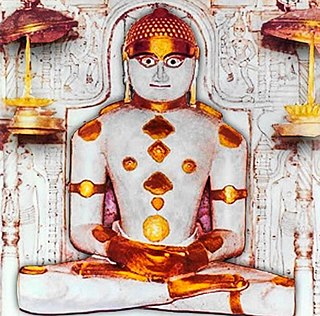
Rishabhanatha, also Rishabhadeva, Rishabha or Ikshvaku, is the first tirthankara of Jainism. He was the first of twenty-four teachers in the present half-cycle of time in Jain cosmology, and called a "ford maker" because his teachings helped one cross the sea of interminable rebirths and deaths. The legends depict him as having lived millions of years ago. He was the spiritual successor of Sampratti Bhagwan, the last Tirthankara of previous time cycle. He is also known as Ādinātha, as well as Adishvara, Yugadideva, Prathamarajeshwara and Nabheya. He is also known as Ikshvaku, establisher of the Ikshvaku dynasty. Along with Mahavira, Parshvanath, Neminath, and Shantinath, Rishabhanatha is one of the five Tirthankaras that attract the most devotional worship among the Jains.
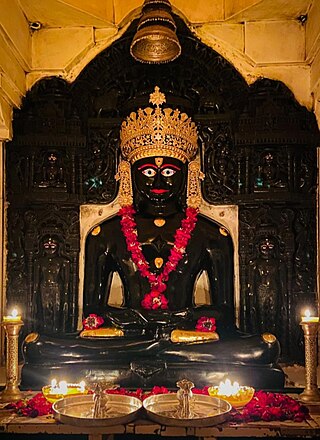
Nemināth, also known as Nemi and Ariṣṭanemi, is the twenty-second tirthankara of Jainism in the present age. Neminath lived 81,000 years before the 23rd Tirthankar Parshvanath. According to traditional accounts, he was born to King Samudravijaya and Queen Shivadevi of the Yadu dynasty in the north Indian city of Sauripura. His birth date was the fifth day of Shravan Shukla of the Jain calendar. Krishna, who was the 9th and last Jain Vasudev, was his first cousin.

Sanskrit moksha or Prakrit mokkha refers to the liberation or salvation of a soul from saṃsāra, the cycle of birth and death. It is a blissful state of existence of a soul, attained after the destruction of all karmic bonds. A liberated soul is said to have attained its true and pristine nature of infinite bliss, infinite knowledge and infinite perception. Such a soul is called siddha and is revered in Jainism.
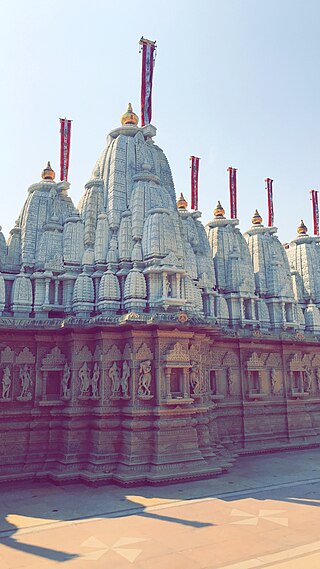
The Shankheshwar Jain Temple is located in the center of Shankheshwar town of Patan district, Gujarat, India. The temple is dedicated to Parshwanath and is an important place of pilgrimage for the followers of Jainism.

Arihant is a jiva (soul) who has conquered inner passions such as attachment, anger, pride and greed. Having destroyed four inimical karmas, they realize pure self. Arihants are also called kevalins as they possess kevala jnana. An arihant is also called a jina ("victor"). At the end of their life, arihants destroy remaining karmas and attain moksha (liberation) and become siddhas. Arihantas have a body while siddhas are bodiless pure spirit. The Ṇamōkāra mantra, the fundamental prayer dedicated to Pañca-Parameṣṭhi, begins with Ṇamō arihantāṇaṁ, "obeisance to the arihants".
According to the Jain cosmology, the Śalākāpuruṣa "illustrious or worthy persons" are 63 illustrious beings who appear during each half-time cycle. They are also known as the triṣaṣṭiśalākāpuruṣa. The Jain universal or legendary history is a compilation of the deeds of these illustrious persons. Their life stories are said to be most inspiring.
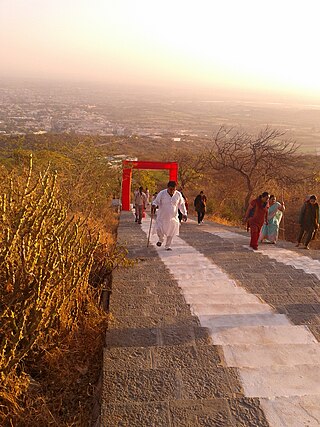
Shatrunjaya or Shetrunjaya originally Pundarikgiri), are hills located by the city of Palitana, in Bhavnagar district, Gujarat, India. They are situated on the banks of the Shetrunji River at an elevation 164 feet (50 m) above sea level. These hills have similarities to other hills where Jain temples have been built in Bihar, Gwalior, Mount Abu and Girnar.

The Palitana temples, often known only as Palitana, are a large complex of Jain temples located on Shatrunjaya hills near Palitana in Bhavnagar district, Gujarat, India. Also known as "Padliptapur of Kathiawad" in historic texts, the dense collection of almost 900 small shrines and large temples have led many to call Palitana the "city of temples". It is one of the most sacred sites of the Śvetāmbara tradition within Jainism. The earliest temples in the complex date as far back as the 11th century CE.

Diwali in Jainism marks the anniversary of Nirvana or liberation of Mahavira's soul, the twenty-fourth and last Jain Tirthankara of the present cosmic age. It is celebrated at the same time as the Hindu festival of Diwali. Diwali marks the end of the year for Jains, and it likewise commemorates the passing of their twenty-fourth Tirthankara Mahavira and his achievement of moksha.

Tirth Pat or Patta is a religious map and topographical rendering used in Śvētāmbara Jainism religion for representing places of pilgrimage (Tirtha). Tirth Pat is different than the conventional map making and is not drawn to scale. Tirth Pat is not indicative of distances, elevation, topography and direction and is solely used for evocation of Jain pilgrimages (Tirthas). It is believed in Jainism that mere viewing of a Tirth Pat earns merit for a devotee.

There is a group of temples of Jainism on Mount Girnar near Junagadh in Junagadh district, Gujarat, India. These temples are sacred to both Digambara and the Śvetāmbara branches of Jainism.
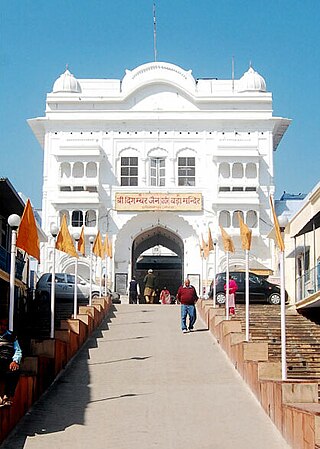
Digamber Jain Bada Mandir Hastinapur is a Jain temple complex located in Hastinapur, Uttar Pradesh. It is the oldest Jain temple in Hastinapur dedicated to Shantinatha, the 16th Jain Tirthankara.

Vividha Tirtha Kalpa is a widely cited Jain text composed by Jinaprabha Suri in the 14th century CE. It is a compilation of about 60 Kalpas (sections), most of them give the accounts of major Jain Tirthas.
The Nābhi-nandana-jinoddhāra-prabandha is a 1336 Sanskrit book in the prabandha genre written by the Jain scholar Kakka Suri (Kakkasūri). The main objective of the book is to record the renovation of the Rishabhanatha Jain temple on Shatrunjaya hill in Gujarat, during the Delhi Sultanate rule. The work also provides other information, such as a history of the author's spiritual lineage (gaccha) and a description of the Delhi Sultan Alauddin Khalji's military conquests.
Vastupāla was a prime minister of the Vāghelā king Vīradhavala and his successor Vīsaladeva, who ruled in what is now the Gujarat region of India, in the early 13th century. Although he served in an administrative and military capacity, he was also a patron of art, literature and public works. He, together with his brother Tejapāla, assisted in the restoration of peace in the kingdom, and served in a number of campaigns against Lāṭa, Godraha, Kutch and the Delhi Sultanate. The brothers were instrumental in the construction of the Luniga-vasahi temple on Mount Abu and the Vastupala-vihara on Girnar.

















